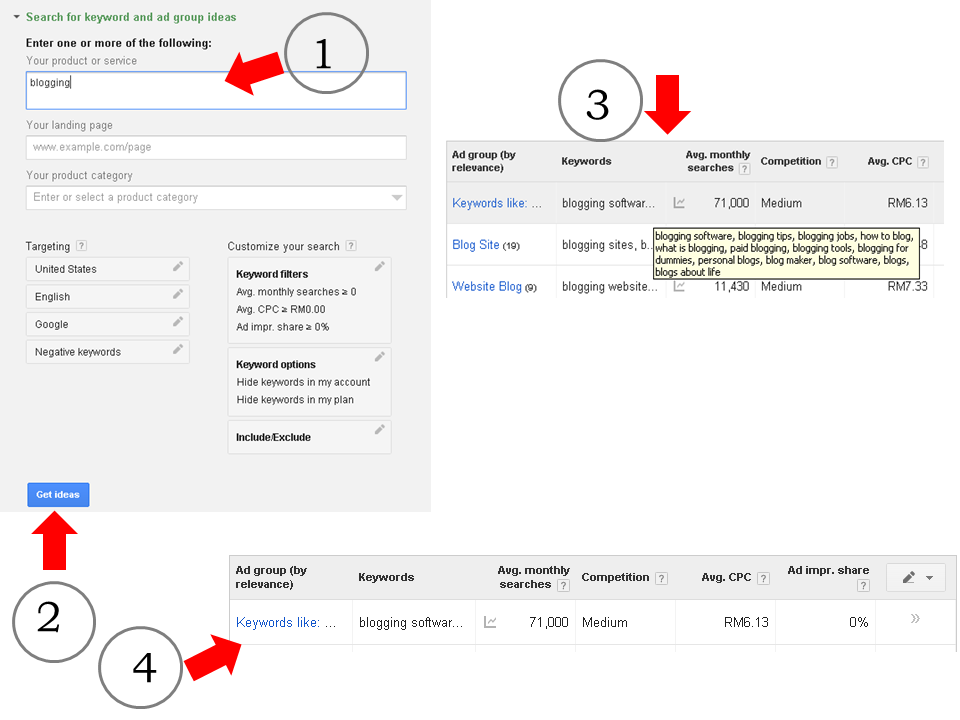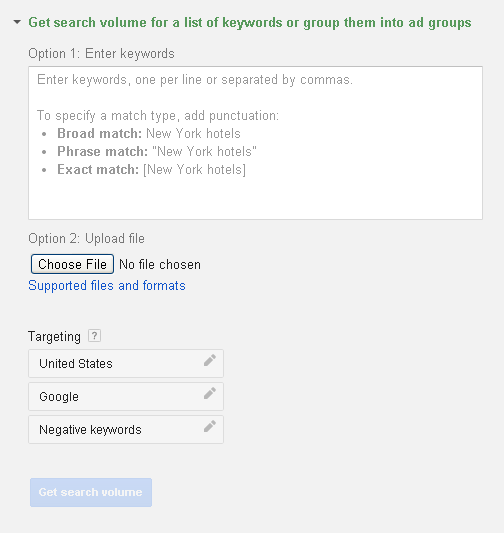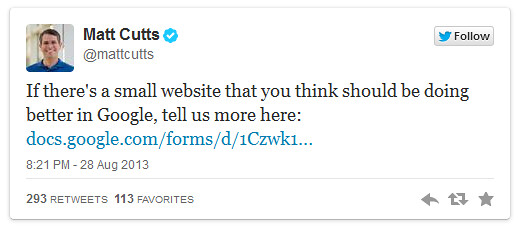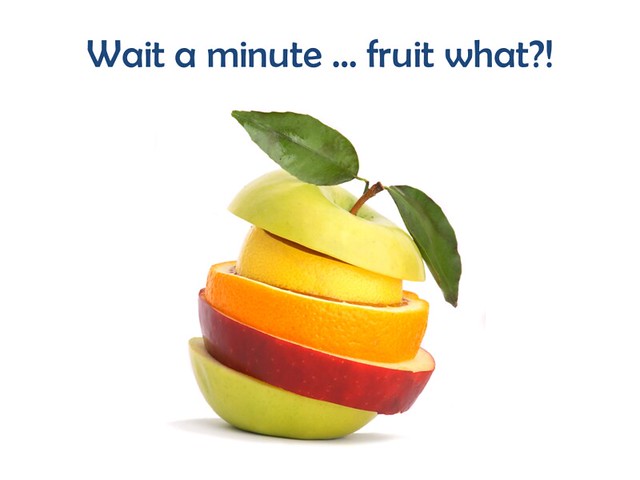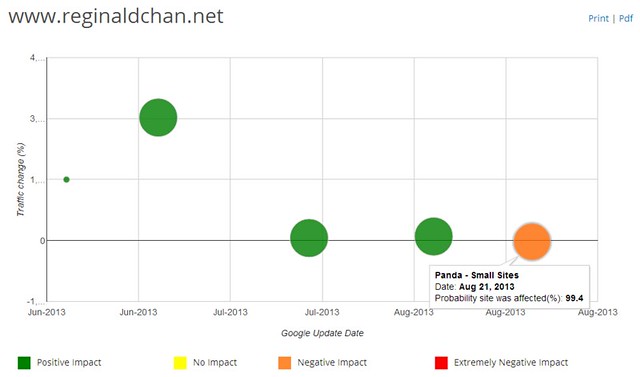Google Update on Small Sites or Google Hummingbird in short could possible be the biggest overhaul done by this giant search engine after Caffeine update. We all know that the latest Google Update took place on 21st August 2013 and at that time, Google didn’t break the news which left everyone wondering.
On the eve of Google’s 15th years celebration, the search engine giant decided to break the ice and basically, took the world by storm; Introducing Google Hummingbird Update.
What is Google Hummingbird?
The Hummingbird update is said to be a major update in terms of how the search engine index works and linking of search queries. Here’s a snippet from a very popular SEO site:
Hummingbird is a definite expansion of Google’s semantic capability evident at the search interface level that reveals, significantly, two things,’ said David Amerland, search engine expert and author of Google Semantic Search, ‘First, Google has increased its ability to deal with complex search queries which means that it also has got better at indexing entities in Web documents. Second, it has got a lot better at relationally linking search queries and Web documents which means that its Knowledge Graph must be considerably enriched. – Search Engine Land
And my take on Google Hummingbird update are as below:
Hummingbird update was rolled out to focus more on the meanings behind the words. For example, search queries will now concentrate more on each word in the search query instead of the keywords only. This means that Google will take account what the whole conversation, sentence or question is all about with the hopes to return more exact search results.
What do you understand from the above? Personally, I love SEO and been a huge fan of it since early 2010. This update seems to be very focused in several parts and which will affect us all dearly;
- Choices of keywords
- Possibility of new requirements to get blogs and articles indexed faster
- The importance of human factor (human intent)
Behold~ Here’s my disclaimer: The above are just the icing of the cake. I will also share with you not one but three simple SEO techniques which can (and possibly) help you rank better on search engines below. So yes, expect this to be a long article. Bookmark this right now and come back for more, from time to time.
Google Hummingbird’s search queries update

As seen above, Google said that they had updated the search queries and for me, this affected a lot on micro niche sites. Before we go deeper into the topic, here’s a simple food for thought question.
How often do you type a two letter words on Google? Possibly one out of ten times maybe?
That’s the whole point!
Nowadays, we are typing nearly a complete sentence whenever we are searching for information. Google algorithm update affects how the search engine figures out what you are actually searching for. In other words, this makes Google better at solving complicated search queries.
This also means that every blog or website has a greater chance of ranking well on search engine if you are using the right keywords. And this my friends, is just one part of it.
Using the right keyword does have its advantages in terms of ranking but there are also many factors you need to consider such as keyword density, using the related keywords and most importantly, the overall SEO practices for the whole website.
Did Hummingbird update really affected the way a blog or website get indexed?

Honestly speaking, I have no idea and if I would, I could possibly be working with Google right now!
I did a quick test recently and I noticed that some of my articles got indexed rather fast (faster than usual). I am not talking about weeks but in terms of days!
So, is this really the effects of Google Hummingbird? What do you think?
Personally, I think there is a strong connection here. Basically, sites who gets lots of ‘publicity’ and social signals could prove to the search engine that “Hey, people are sharing my writings and so should you (Google)”.
More social shares could help to speed up the time needed for search engine indexing.
Like what I said above, there are many factors affecting how a blog or article get showed up on search engines but it is safe to say that proper keyword usage is more important than ever.
Google understands that everyone (including you and me) are often using specific keywords to rank an article. However, the biggest question for this is how far does that particular keyword helps in enriching the article?
Just because we had used that keyword a dozen times doesn’t prove that it is related to the article at all.
Top SEO techniques to counter-attack Google Hummingbird

It doesn’t matter if Hummingbird affected your website but you are here because you want to rank your blog better. If you are not, please … please click on the ‘X’ button on the top right of the screen now.
Before I disappoint you, allow me to be completely honestly with you. These are not your usual SEO techniques but they work extremely well for me.
My goal is to have a balance mixture of psychology (human intent), content and authorship to boost the overall SEO ranking. Personally, I call this indirect SEO.
These SEO techniques I am about to share with you are mostly two sided blades. A wrong move could easily crumble your SEO strategies and even backfire on your blog. However if practiced correctly, you stand a good chance to skyrocket your blog traffic.
1. Content do not need to be SEO rich

Yup, you hear me right. If you have focus a lot on your blog or website content and positing well on search engines, you do not need to pay thousand of dollars to SEO agencies to do it for you. Plus, you can get all the basic SEO strategies using Yoast SEO plugin.
Seriously!
Gone were the days where SEO is the only factor when it comes to blog ranking. It is not debatable that SEO still plays a factor in terms of blog ranking but there are far more important factors which could affect it.
If you are about to publish a blog post, ask yourself these, “Will my readers be happy with what they read? Is this what they are looking for?”
You see, building a good and strong presence is vital when it comes to surviving in this blogging industry. This is why you need all hands on deck and making sure your content is not only able to fulfill but to satisfy your readers which leads to point #2.
If you want to score well in SEO, then you need to know the basics and you can start off by checking out these articles:
- Complete Search Engine Optimization for Dummies
- 8 Explosive Blogging Tips Other Clever Bloggers Won’t Share
2. Rich quality content is definitely needed

This is some sort of a no-brainer. Words around popular search engine forums are saying that Google is looking for more unique content than just plain articles.
Now let’s see this in the perspective of a reader, shall we?
Imagine reading through 5 different blogs and all of them are sharing the same information. The only difference between them are the titles and headings. Does this really enrich your search experience?
Definitely not!
When you are blogging, make sure that you are NOT doing what others are doing … or at least try not to. Of course, with over 60 million blogs out there, this is rather insane and impossible to accomplish but at least, you don’t copy and paste everything that you read.
Readers love to read contents which are unique and they could possibly not find any of those anywhere else (yet). Do this and you will find them coming back for more and if Google sees good traffic coming from your blog, it is a signal to send even more traffic towards your blog.
Take a moment to think about this. Does this makes all the sense to you?
If you want to read more about this, I highly recommend you to read this article, Top 6 Blogging Tips To Build Better Blog Ranks.
3. The love-hate authorship factors

Let us go back memory lane for a moment. When Google+ was first announced, it was a huge hype and everyone was trying to enable Google Authorship on their blogs.
We all thought that it was a good way to boost SEO and so long live the hype until recently. A long discussion was done recently among Google+ community and it was confirmed that Google Authorship doesn’t affect SEO at all.
So, here’s the question, “What is the relationship between content authorship and Hummingbird?”
This is because content seems to be the biggest emphasis for Hummingbird update, it is very likely that authorship (which is rather useless somewhere now) will become an important factor when it comes to optimization.
We all know Google had long been trying to compete with Facebook and thus, Google Authorship could be the only thing that distinguish both the social media platforms.
With proper Google authorship settings, Google is able to attribute the content back to the author and yes, publishing a pretty face right below the URL.
And you might be thinking … you ain’t got the time to enable Facebook graph, fail to enable Twitter cards or probably, had no idea what Google Interactive Post is all about. I got it, really.
Personally, I have always wanted to enable these features with some coding but thanks to my limited knowledge on the matter, most of the time it ended up as a disaster until recently.
I came across WPSocial thanks to Ana Hoffman from Traffic Generation Cafe when she published Schema Markup. I wouldn’t even thought of bringing this up until Hummingbird update and all the hype about Google Authorship plus the open graph features.
Then it struck my mind on how important Open Graph and all these microdata is for bloggers. Thank God I was using WPSocial SEO Booster.
In short, WPSocial SEO Booster is used to make sure that proper markups are done correctly for your blogs. It may and may not have a difference when it comes to the naked eyes but this is a whole different scenario when it comes to search engines.
If you have read above, you would know that authorship is important and it is a great way to prove to search engines that you are genuine. WPSocial SEO Booster will help you in terms of:
- Creating correct microdata for your blog
- Enable authorship markup
- Facebook Open Graph integration
- Twitter cards
- Increase site performance
- Review features, social sharing button and Google Interactive features included
- And a dozen more features …
The main reason for me to bring this up is because it had helped me a lot in terms of additional marking up features. Don’t get me wrong. I love Genesis Framework and the HTML5 markup is extremely useful.
However in this SEO and blogging industry, I need more than that to compete and therefore, I opt to try WPSocial which turned out to be great!
You can try WPSocial today for only $29.60 and ask for a refund if you are not happy with it. No strings attached and there’s an offer Mike (developer of WPSocial) is throwing in … a whopping 20% discount if you try it out during October 2013.
Again, don’t take my word for it as it might be biased. However, I see no reason why you shouldn’t give it at least a try since you are given a guaranteed refund and a nice discount right?

Try WPSocial today and get additional 20% discount of your total bill now!
So, what is the future that lies in Google and search engines algorithm?
The way I see it, Google is trying to make its search queries even easier to manage and control. This means that producing better search results for all of us.
And if you ask me, I dare to say Google Hummingbird have affected many sites. I noticed is that many micro niche and general blogs were hit pretty bad from this update even though I know some survived the impact.
Personally, I know a few niche bloggers who had huge drop in traffic from about a thousand visitors a day down to 250 or less.
Here’s my take on this. Google is trying to reduce the number of micro niche blogs showing up on search engine result pages and I totally understand it. Not just any micro niche blogs but those with low quality.
From Google’s perspective, it could mean that bloggers are trying to ‘influence’ the search engine rankings just to earn extra income. And trust me, it is rather easy to rank well on search engines as long as you are able to find low competition keywords.
Furthermore, how many micro niche blogging sites that are really that good in terms of quality? Most of them are living of affiliate sales or Google Adsense. So yes, go figure!
From the point of a blogger myself, running a micro niche blog doesn’t mean that we are doing any black hat SEO. We are just trying to rank well using low ranking keywords. Of course, we are sharing information that we might not know at all and practicing keyword stuffing which isn’t really right.
Well, I am not saying that all micro niche bloggers are bad as I know quite a number of bloggers who are really experienced and sharing specific niche blogs to help others.
It’s just that there are many other bloggers who are trying to replicate the same success with the hopes of earning more money online and indirectly, affecting the search results one way or another.
So, Hummingbird update could be a way to control the number of micro niche sites showing up on search engines. This means that Google want those niche blogs to rank well only if they have quality contents.
For me, that’s a very good deal indeed. Okay, I know this is going to spark a lot of controversial and thus, I am going to leave it as what it is right now.
Did I miss out anything?
Let’s face it guys. Google is continuing its journey where ‘Content is King’ and understanding user search intent is the end goal. It is all about improving the search engine results and I think it is doing very well indeed.
However, this had a great impact on bloggers and the latest update from Google really says it all. SEO is ever changing and the biggest question now is, “Are you (and your blog) up for the challenge?”
What do you think about this? Agree to disagree? Hit the reply button below and let’s discuss.







